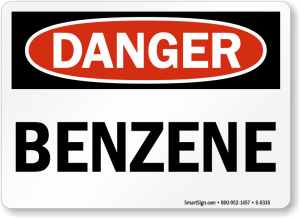
Benzene is a health hazard and is everywhere. Since the 1940s, it has been well-known that there is no safe exposure level to benzene. Long-term exposure to benzene is linked to bone marrow failure, anemia, and leukemia. Benzene is also a mutagen that damages DNA.
Breathing benzene vapors is the most common exposure path. Common industrial sources include the rubber industry, petrochemical industry, and in other places that use or process benzene. Other common non-industrial sources of exposure include car exhaust, gas stations, and tobacco smoke. Tobacco smoke is the most common source of exposure.
On rare occasions, low levels of benzene can be found in sodas. Benzoic acid, a common preservative, sometimes reacts with the Vitamin C in some drinks to produce low levels of benzene. (For comparison’s sake, a contaminated 12-ounce soda exposes you to the same amount of benzene as a motorist filling up a gas tank.)
OSHA regulations limit benzene exposure to 5 parts per million for 15 minutes, or 1 part per million over 8 hours. When handling benzene, use personal protective equipment, such as face shields, protective clothing, and respiratory protection, as appropriate.